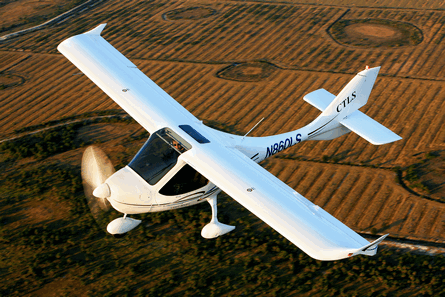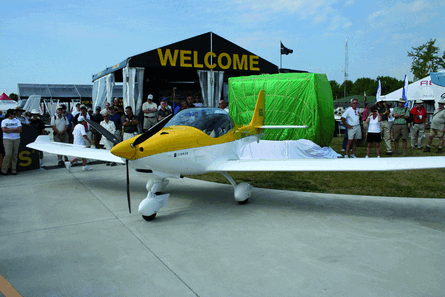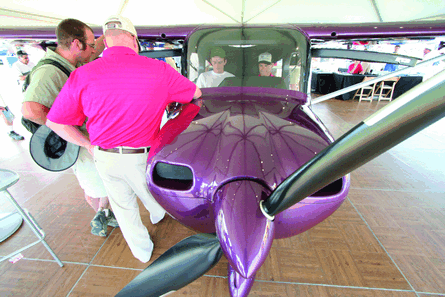The entry of general aviation giants Cessna and Cirrus into the three-year-old light sport aircraft market may be responsible for a dip in orders by most of their newest and smallest competitors.
Registration of special-light sport aircraft (those built in factories) in the first two months of 2008 is down by 15% compared with the year before. Even so, the average number of S-LSAs delivered each month rose by 56% in 2007 to 45.
January's US Sport Aviation Expo in Florida saw a dozen new two-seat aircraft enter the market, with European manufacturers on track to hold their two-thirds share. Sales were expected to be boosted at the recent Sun 'n Fun show in Lakeland, Florida, with a bigger sales jump expected at the AirVenture show in Oshkosh, Wisconsin in July.
"We continue to maintain a situation where the 80/20 rule applies, where 80% of the sales are made by 20% of the producers," says Dan Johnson, chairman of the Light Aircraft Manufacturers Association (LAMA). "That's actually closer to 90/10."
The market leader is Flight Design of Germany, whose chairman Mathias Betsch believes the expanding authority of the European Aviation Safety Agency and its impending European light aircraft category will bring uniformity to regulations, will cut costs and beckon to new pilots, with even stronger results than achieved in the USA. "With that, I think the market will double or triple in Europe," Betsch says.
 |
|---|
© Flight Design |
Weight requirements for ultralight and microlight aircraft are tighter by 150kg (330lb) compared with LSAs, meaning many of the larger aircraft are operated as experimental in their home countries. And an expected relaxing of regulations of the light aircraft pilot's licence would mean a private pilot's licence will not be required to fly them.
Czech Aircraft Works stopped making ultralights in 1997 in favour of LSAs. President Chip Erwin says the 900 aircraft shipped since then have nearly replaced the ultralights.
"The worldwide demand is already considerably higher than projected. We expected to ship 95% of our production to the USA, but can barely supply 50% due to the non-US demand.
We have orders from Australia, New Zealand, South Africa and several countries in South America. Although we did triple our production, we still have nearly a one-year backlog of orders," he says.
The lawns of Sebring regional airport near Tampa Bay, Florida were filled with hundreds of light sport aircraft in January while the 150 exhibitors reported strong sales of fixed-wing aircraft, weight-shift trikes, powered parachutes, motorgliders, gyroplanes and their accessories.
Randy Schlitter, president of Kansas-based manufacturer RANS, says: "People come here for a specific purpose: to shop for an airplane and nothing else."
Cirrus chose the show to open the orderbook on its SR Sport (SRS) light sport aircraft six months after its surprise debut at the 2007 AirVenture show in Oshkosh. Refundable $5,000 deposits were taken and deliveries could begin by 2009. The SRS is a modified version of the FK-14 Polaris it bought from Germany's FK Lightplanes. "They will have delivered all of their FK-14s by the time the SRS is on the market to try and control any market confusion over the products," says Cirrus. "The SRS will look very similar to the FK-14, but functionally be very different." The specifics on distribution are under wraps, but it is "going to be very different then the current SR series".
 |
|---|
© Jeffrey Decker |
Details released by Cessna at Sebring did little to stifle grumbles over its December announcement that its SkyCatcher LSA will be built in Shenyang, China. Acceptance tests and reassembly will take place at Eagle Aviation in West Columbia, South Carolina Yingling Aviation in Wichita, Kansas and Southwest Platinum Aviation in Las Vegas, Nevada. The engine and avionics, along with raw materials, will be shipped to Shenyang for assembly.
 |
|---|
© Jeffrey Decker |
Wichita Upset
A vocal segment of the Wichita-based manufacturer is upset that SkyCatcher production is in China, and that the cost is 10% higher than the expected $100,000. In Oshkosh the orderbooks have been opened and more than 700 orders were placed in four days. On 10 March the prototype flew for the first time.
As expected, Cessna instantly rivals sales leader Flight Design, which achieved a 20% market share with delivery of 228 CTSW all-composite two-seaters by 2 January. "In the last six to seven years we've had a minimum 30% expansion [of production rate]", says Betsch.
The production rate at the company's Ukraine plant is 50 a month. Flight Design will distribute to anywhere that accepts ASTM International industry standards of design and manufacture, and anywhere service is available.
"The biggest problem at the beginning was that we wanted to build up service stations, but the people didn't have enough aeroplanes to service! It was only a matter of time," he says.
The German company's latest model is the CTLS, introduced at Sebring and already breaking company sales records, says its USA president Thomas Peghiny. "We've sold 40. There's even more interest from flight training than we predicted," he says.
Also at Sebring, German manufacturer S-Wing broke into the US market. Brazilian manufacturers broke the US barrier with the amphibious SeaMax and the high-wing Paradise S-1.
Skykits of Canada brought its own high-wing Rampage, while Italian company Tecnam hopes for high demand for its fourth model, the Eaglet. The first all-new aircraft designed in the USA for the LSA category, the S-19, has been introduced by RANS.
The popularity of microlights in the Czech Republic has led its manufacturers to overall market dominance and a 31% market share.
At Sebring Americans saw Gobosh Aviation's new 800XP and Urban Air's Lambada, which has sold well in Europe as a powered glider.
The Slovak-designed Dynamic WT9 has a new LSA version, and the Czech presence could grow with the new Sting S3 from TL Ultralight. A production rate of eight aircraft a month keeps business steady for TL UIltralight, which has delivered 57 StingSports to the USA.
"We had our growing pains. We had our difficulty setting up our international network, but I think the success is based on the fact that our Sting is one of the nicest aircraft out there," says David Dobogai, general manager of TL Ultralight.
That sales network means it is not dependent on US sales alone. The ultralight regulations met by the company's aircraft internationally almost always require a lower maximum take-off weight than the LSA category in the USA, so Dobogai says every Sting shipped there has a larger wingspan, which boosts lift and lowers the stall speed.
"They are, in general, more well-equipped than the aircraft we sell to the rest of the world," he says, noting that the higher MTOW allows more avionics and accessories and requires a larger wing.
First High Wing
Targeting older pilots who are attracted to the lower operating costs and looser regulations of sport pilots has led to final assembly of the 3000 Sirius prototype, TL Ultralight's first high-wing aircraft.
European and US versions will at last be the same after EASA and the European Commission finalise the shape of the new European light aircraft category.
EASA's MDM.032 working group will meet on 1-2 July in Paris and its notice of proposed amendment on initial airworthiness is expected imminently.
A three-month comment period will precede release of a comment response document. The new category could become effective in mid-2009. An EASA workshop hosted by LAA-CR and LAA-UK will explain European light aircraft initial airworthiness at Aeroexpo in Prague on 25 April.
The new light aircraft pilot's licence simplifies pilot requirements for non-commercial operation of aircraft weighing less than 2,000kg with five or fewer seats.
That could change to four seats during the consultation period as EASA considers the new oversight proposed by its working group. Its new pilot's licence is ready but waiting on the EU to vote on EASA's competency regarding licensing and flight operations. EASA already has competency over airworthiness and continuing airworthiness.
It is the largest test yet for EASA consolidation of European skies, with changes to attract new pilots and ease manufacturing costs of light sailplanes, aircraft, rotorcraft and balloons.
Requirements are also simpler under "ELA I" for aircraft and certain dirigibles below 1,000kg, dropping the need for traditional design approval and exempting owners from traditional stringent maintenance requirements.
ELA II, for aircraft with initial take-off weights of up to 2,000kg (excluding light rotorcraft) allows for simplified design, "including the one-man organisation". It uses simplified certification specifications dependent on industry standards for design and construction, but that process is checked by the manufacturer's home's civil aviation authority.
With working group members hailing from aviation authorities of member states, the European Council of General Aviation Support, Europe-Air-Sport and the International Council of Aircraft Owner and Pilot Associations, broad acceptance is expected, although members of the microlight community are disappointed over being lumped in with heavier aircraft and their regulations.
Acceptance of light sport aircraft continues. Chile and Colombia have adopted ASTM standards, Argentina and Brazil have shown interest in LSA, and a committee in Israel is considering acceptance. South Africa is accepting aircraft built to standards and Australia and New Zealand were early LSA adopters.
When Europe joins their ranks, LAMA's Johnson does not imagine imports into the USA will slow. "I think the USA will remain more than 50% of the entire light sport type market. That's been the case if you add both light sport in the USA and microlight and other ultralight definitions."
Fewer than 10 US manufacturers will break into the new European market, he predicts. "I don't think it'll be a flood, I think it'll be a little slow, but the US dollar/EU euro exchange rate is powerful."
He says there is not much interest in selling to the 350kg market, but "at such point when the same exact product can be sold in the US can be sold in Europe, albeit with things like adjustable pitch prop..."
LAMA president Tom Gunnarson is nearing his tenth compliance audit announced at Sun 'n Fun last year. "From the beginning there have been those who have not fully embraced this idea of allowing an industry to self-declare compliance, especially to that level," he says.
"The US Federal Aviation Administration is happy with the safety record so far," he adds. "The FAA made it clear that it would behove the industry to self-regulate and to do that visibly. They basically gave us our marching orders to put together that programme where we, the industry, would self-police."
Self-Regulation
A growing portion of aircraft include recovery chutes, and Gunnarson has contractors en route to audit Ballistic Recovery Systems, the first non-airframe manufacturer to be audited.He wants engine and propeller manufacturers to follow, but he notes that not every airframe producer is ambitious enough to request an audit or even to produce aircraft.
"There are a bunch that remain in the single digits. If they've been around a while, it gives reason to wonder if they should be considered. At what point do you call them niche manufacturers that aren't giving real numbers to the fleet?" he asks.
Many aircraft lighter than 600kg with two seats can be operated as light sport aircraft, and owners felt a long shadow across their aircraft as the young category closes in on covering two-place "fat" ultralights as well.
Owners have until summer to complete the airworthiness certification process to the experimental light sport aircraft (E-LSA) category.
The deadline had been in January, but an extension was granted after FAA inspectors and designated airworthiness representatives were overwhelmed by the 4,273 E-LSA-registered vehicles requiring certification.
"The last thing we want to see happen is they end up with an expensive lawn ornament," says Earl Lawrence, vice-president of industry and regulatory affairs for the Oshkosh-based Experimental Aircraft Association.
Source: FlightGlobal.com



















